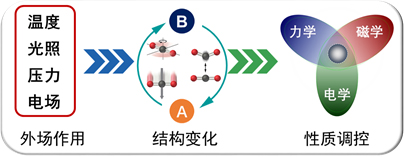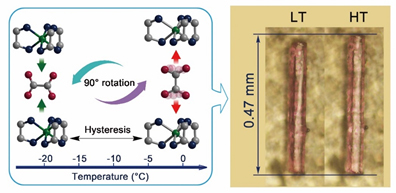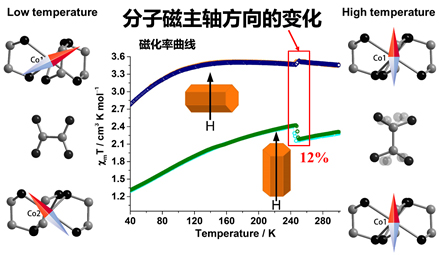
Design and synthesis of dynamic crystalline materials
 分类:research
分类:research
 作者:
作者:
 发布时间:2019-05-13
发布时间:2019-05-13
Dynamic single crystal refers to the single crystals whose structure can be significantly modulated by external stimuli—such as light, electric field, temperature, and pressure. As a consequence of structure-functional relationships, the physical properties of materials can be switched accompanied with structural variation. The structural flexibility of dynamic single crystal provides an effective avenue for tuning the physical properties of materials through external stimuli.

Figure 1. The physical properties of dynamic single crystal controlled by external stimuli.
The structural variation can actuate a remarkable change in the cell parameters of single crystal, manifesting as an unusually thermal expansion or jumping of single crystal; The structural variation can alter the coordination environment of spin centers, tuning the magnetic behaviors of materials; Furthermore, if the structure can be significantly modulated by electric filed, the materials may demonstrate interesting dielectric or ferroelectric properties. In our previous research, we obtained several flexible crystalline materials that possess unusual physical properties, as below:
Mechanical response: Through thermodynamically assisted 90° rotation of oxalate anions, we demonstrate a single crystal of Ni(II) can perform abrupt expansion/contraction along the crystal long axis as the temperature varies. The unprecedented molecular motion of oxalate, which was unambiguously revealed by variable-temperature dependent single-crystal X-ray diffractions, was thoroughly discussed experimentally and theoretically (Figure 2).

Figure 2. The abrupt single-crystal expansion induced by rotation of oxalate dianions.
Magnetic switching: Apart from the mechanical response, the Co(II) analog demonstrates an unusual anisotropic magnetic switching as a result of directional change of molecular magnetic moment triggered by symmetry breaking of Co(II) coordination environment from D3 to C1 (Figure 3).

Figure 3. Anisotropic magnetic switching in a single crystal of Co(II).
Dielectric properties: The spontaneous polarization of pure organic single crystal was switched by structural variation of H-bonded trimer unit, i.e., diprotonated 1,4-diazabicyclo[2.2.2]octane shifts between two 2‑chlorobenzoates (Figure 4).

Figure 4. A pure organic co-crystals with above room temperature ferroelectric properties.